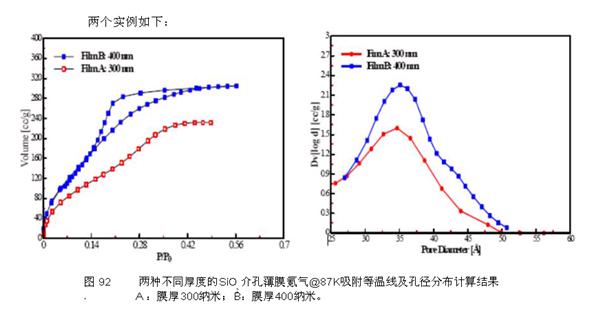300? A wide range of applications are available in many fields. The introduction of mesopores in the film facilitates further reduction of the dielectric constant of the material. It can be said that thin silicon dioxide The dielectric constant of a film is closely related to the pore size distribution and pore volume of the material. Usually, a mesopores of less than 10 nm are used to reduce the film. The dielectric constant can play an important role. Holes larger than 10 nm in the film are often caused by the development and manufacturing of such materials. The cause of device manufacturing failure. However, measuring the pore size distribution and pore volume in such films is quite difficult. The gas adsorption method is 10 nanometers. Conventional characterization of the right and left holes. In general, the adsorption of nitrogen, argon and helium at 77.35K or 87.27K can be used to calculate more The specific surface area, pore size, pore distribution and pore volume of the pore material cannot be characterized by conventional nitrogen and argon. this is Since the total pore volume and surface area of ​​the film material are very small, the pressure difference caused by the adsorption is also extremely small. ? Recently, a new method for determining the pore size of thin film materials has been established, and helium gas is used for aperture measurement. This method has been built in 3H-2000 Series of fully automatic physical adsorption analyzers. This method is not only applicable to silica-based mesoporous film materials, It is suitable for mesoporous materials with surface oxidizing properties. ? ? ? ? This method chooses to use liquid argon temperature (87K) instead of liquid nitrogen temperature (77K) because: 1) 77K In the case of a device equipped with a molecular pump and a low pressure sensor, the saturated vapor pressure of 13torr can be pore size analysis, even Microwell analysis (down to 0.7 nm) provides sufficient resolution. ? 2) The mathematical relationship between the mathematical expression of the physical phenomenon and the pore size change is a prerequisite for the pore size analysis. Research shows that at 77K At the temperature, helium gas will simultaneously undergo capillary condensation and desublimation in the pores. However, only capillary condensation occurs at 87K. ? • When applying this method, the adsorption of helium at liquid argon temperature is first corrected. The calibration process is as follows: 1, using a well-recognized highly ordered mesoporous material as a reference sample (such as MCM-41, SBA-15 or MCM-48) in nitrogen Adsorption measurements were carried out under gas (77K) and argon (87K) conditions, and geometrically shaped pores were calculated by the NLDFT method. Diameter and pore volume (extrapolated to the microwell interval). ? 2. Measure the helium (87K) isotherm of the above materials and correlate the pore size according to the harvest of the first step. Thus, the film hole The diameter distribution can be obtained by the NLDFT method. ? 3. The density of the liquid phase condensed in the pores can be (a) the pore volume of the known mesoporous material used in the first step and (b) the helium gas. The amount of adsorption is calculated. The average liquid phase enthalpy density obtained in the test was 2.6 g/cm. 3 , consistent with theoretical calculations. Then, The total pore volume of the film can be calculated from the density of the liquid phase. ?
A siren is a loud noise-making device. Civil defense sirens are mounted in fixed locations and used to warn of natural disasters or attacks. Sirens are used on emergency service vehicles such as ambulances, police cars, and fire trucks. There are two general types: pneumatic and electronic.
Many fire sirens (used for calling the volunteer fire fighters) serve double duty as tornado or civil defense sirens, alerting an entire community of impending danger. Most fire
sirens are either mounted on the roof of a fire station or on a pole
next to the fire station. Fire sirens can also be mounted on or near
government buildings, on tall structures such as water towers,
as well as in systems where several sirens are distributed around a
town for better sound coverage. Most fire sirens are single tone and
mechanically driven by electric motors with a rotor attached to the
shaft. Some newer sirens are electronically driven speakers.
Fire sirens are often called "fire whistles", "fire alarms", or
"fire horns". Although there is no standard signaling of fire sirens,
some utilize codes to inform firefighters of the location of the fire.
Civil defense sirens also used as fire sirens often can produce an
alternating "hi-lo" signal (similar to emergency vehicles in many
European countries) as the fire signal, or a slow wail (typically 3x) as
to not confuse the public with the standard civil defense signals of
alert (steady tone) and attack (fast wavering tone). Fire sirens are
often tested once a day at noon and are also called "noon sirens" or
"noon whistles".
The first emergency vehicles relied on a bell. Then in the 70s,
they switched to a duotone airhorn. Then in the 80s, that was overtaken
by an electronic wail.
Piezo Alarm,Siren And Alarm,Piezo Buzzer Siren,Piezo Buzzer Alarm Siren Jiangsu Huawha Electronices Co.,Ltd , https://www.hnbuzzer.com
? 